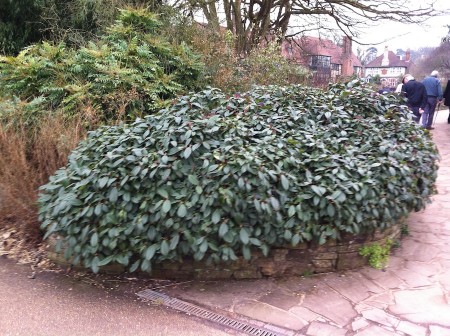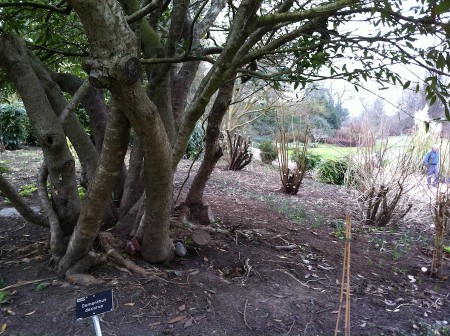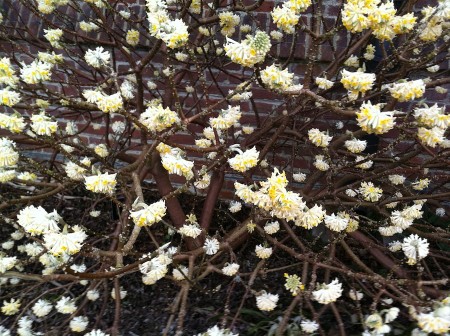Do I sense a feeling that shrubs are coming back into fashion? Or at least that perhaps the New Perennial revolution has just gone a little too far? Over the last few years I have seen the odd article, one by Roy Lancaster and one by Dan Pearson on the basic theme of ‘let’s not forget shrubs’ and Gardens Illustrated have even commissioned Dan to write a series about them.
Back in the day, well, let’s say the late 1980s, shrubs dominated garden centres and nurseries, with perennials relegated to horrid little plastic bags in cardboard boxes for a few spring months. We had to fight to get perennials their place in the sun of the sales area. Now it is the other way round. Most GCs and nurseries carry only the most basic range of rather predictable shrubs clearly designed to appeal to bored suburban gardeners: bright flowers, variegation and compact habit compulsory. The number of specialist nurseries doing a decent range has greatly diminished and there has been a massive cull of woody plants from The Plant Finder.
The reasons are perhaps not difficult to imagine:
- perennials fit smaller gardens,
- they often achieve a ‘final effect’ in two years,
- they are completely unthreatening to the nervous gardener, except for the odd runner like Euphorbia cyparissias (which clearly terrifies the nervous or the tidy-minded),
- they don’t need complicated pruning, or a “what am I going to do, shall I get a man in?” kind of panic attack when they get too big,
- finally, big point, perennials are much cheaper for nurseries to produce; let’s face it, most perennial nurseries buy in their stock as tiny plugs, pot ‘em and flog ‘em, whilst the real specialists (some might say the only real nurseries) who actually propagate their own stock (shock horror – very few do these days) can always take a sharp spade to unsold perennials at the end of the year, pot up and re-sell – can’t do that with shrubs.

Viburnum davidii - the sort of shrub which does the evergreen blog job very stylishly with a minimum of care - but patience is needed.
The perennial take-over, for which I must admit, I have something to be responsible for, ignores these factors:
- after the big winter cut-back there is nowt to look at,
- few perennials flower in spring,
- what does perform in spring flowers so low down the garden can look rather flat,
- no bird nests in a perennial.
This last is an important bio-diversity point, as garden wildlife benefits more than anything else on a diversity of habitat – for which woody plants are essential.
Part of the problem with shrubs is how you manage them. Most have a blob-like shape which creates problems in small spaces if allowed to get too big. The response so often is mindless cutting back to turn an amorphous blob into a kind of sub-spherical blob which does not flower properly – which rather defeats the object of growing it in the first place. Unless you are Mexican, in which case you cut it into a cube. Or a Mexican employed by a US landscape company (or should I say vegetation control company) in which case you cut it into a very tight sphere with plenty of bare wood showing. One of the recent developments which disturbs me, with the banks of ‘green cement’ planting installed by unimaginative landscape architects working for penny-pinching clients in much British corporate planting, is the increasing tendency to annually cut it all back to a ‘shape’. Sometimes this is done quite artistically. Sometimes. But in sustainability terms it is appalling – all that fuel to power the hedge trimmers. What’s wrong with the plant’s natural shape?

Taking out lower limbs gives you planting space beneath for shade tolerant perennials and can give shrubs more character
So, yes, perhaps this is the problem. Management. Some ideas, all of which require a bit more than mindless trimming:
- Knowledge and skill required: prune properly, usually after flowering, keeping the basic plant shape but not letting it get too big.
- Bravery required: cut down to base when it gets too big, and let it regenerate. Most shrubs regenerate from the base very well (this will be the subject of a later blog). It will look very bare but not for long.
- Creativity required: take out lower branches, revealing lower stems – sometimes attractive in their own right, but allow those straight vigorous new ones to shoot up from the base to gradually regenerate the plant. There will now be space for underplanting with bulbs and perennials, and there is a good chance you will have overcome the ‘amorphous blob’ problem.
Finally – the shrub revival now has its Bible: Jim Gardiner, RHS Director of Horticulture has an incredibly thorough new reference book out on shrubs – 1700 species and cultivars. A ‘does what it says on the tin’ book, basic information plus photographs – photographs which do give you a very good feel of growth habit, size and shape, not just ‘grow me, I’m pretty, the art editor likes me’ type illustrations. It should prove to be very useful for a new generation prepared to slip the odd shrub in amongst the perennials.

Skilled pruning here - a complete regeneration job. notice the strong upright young stems which will regenerate the plant.
Check out my own blog at: http://noels-garden.blogspot.com/
and more to read on my Amazon page, including essays, interviews and more on Kindle.
Coming soon! Dig, Plant and Bitch, the Soap Opera for Gardeners.

